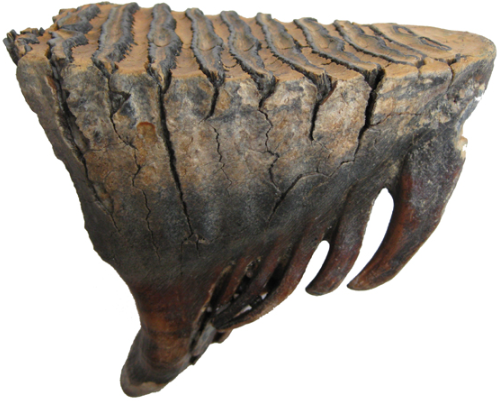Palaeontological Evidences
PALAEONTOLOGICAL EVIDENCES OF ORGANIC EVOLUTION
1. FOSSILSPaleontology-fossil
Study of the past lived organisms which are not now on the globe or fossils is called Paleontology. Normally hard parts like spicules, setae, chitinous exoskeleton, shells, spiny exoskeleton, scales, bones, feathers, teeth and hair of past lived organisms were preserved as fossils.

2. FOSSILISATION
It is the process of formation of fossils of past lived organisms. Normally an animal becomes fossil due to sudden environmental change. Majority of the fossils are formed by Petrifaction. It is the process of replacement of organic matter by minerals like sand, lime, iron oxides etc. In petrifaction decomposers decompose the organic matter of dead organism. In such places minerals precipitate. The minerals become hard to form into a rock. This rock resembles to the dead organism.

3. FOSSILS COLLECTION
Fossils are exposed due to natural erosion of the soil or by excavation (digging of the soil). In India fossil collection and observation are being conducted by BirbalSahni Institute of Palaeobotany, Lucknow. It observed three fossil parks in India.

A. Deccan plateau of Mandla district, M.P: The paleontologists collected 50 million years old fossil forest trees.
B. Rajmahal Hills, Bihar Wikipedia: Scientists collected 100 million years old fossils.
C. Coal mines of Orissa: Scientists collected 260 million years old fossils.
4. FOSSILS-TYPES :
The fossils are four types. They are unaltered, altered, Moulds and coprolite fossils.
A. Unaltered fossils: These are unchanged fossils. These are dead bodies of past lived organisms, preserved as fossils without any change.
Examples: Wooly mammoths found in ice mountains of Siberia, Hexapod fossils found in the amber resin of California in U.S.A.

B. Altered fossils: These are the changed fossils. These are formed by Petrification. Majority of the fossils are of altered type.
Examples: Archaeopteryx fossil was collected from calcium mines of Bavaria state in Germany. Eusthinopteron and Ayshaea are also altered type.
C. Moulds: Moulds-fossils: These are the impressions of body, foot and leaves of past lived organisms. Normally plant fossils are of this type.

D. Coprolites: Coprolites-fossils: These are the faeces fossils of past lived organisms. The coprolites help to decide that the faeces is of a herbivore or carnivore or omnivore but not of a particular animal.

5. GEOLOGICALTIME SCALE-
According to geologists, the approximate age of earth is about 5000 million years. The soil contains different layers(igneous,sedimentary, metamorphic). The layers are formed one after another So the bottom layer is the oldest layer and upper layer is the youngest layer Majority of the fossils are found in sedimentary rock layer The age of the rocks and fossils are calculated by using Carbonl4, Uranium238 and Potassium 40. Normally C is used. Hence this technique is called Carbon dating method. The age of the rock or fossil is calculated by the following formula.
The age of earth is divided into eras. Each era is divided into periods. Each period is divided into epochs. Name of the era, periods, epochs, origin and dominance of animals are represented in the form of a gelogical time scale.geologica-time-scale
6. GEOLOGICAL TIME SCALE - OBSERVATIONS
A. Precambrain period:
- The Archaeozoic and Proterozoic eras together called Precambrain era as they occured before cambrain period.
- In the first eleven hundred million years of archaeozoic era there was no life. Hence the first part of archaezoic era is
- called Azoic era. The animals of precambrain did not contain hard parts. Hence fossils are very less in that period.
B. Palaeozoic era: In this era, advanced invertebrates and primitive vertebrates (Fishes,Amphibians) arose.
C. Mesozoic era: In this era, reptiles dominated and Archaeopteryx (first bird) and primitive mammals arose
D. Coenozoic era: Paleontologists collected the complete ancestral history of various advanced mammals like horse, camel, elephant etc.
Scientists collected the fossils that contain the characters of two groups. These are called missing links. These are
I. Archaeopteryx: This missing link was collected from Jurassic period. The Archaeopteryx contains the structures of both reptiles and aves.
ii .Eusthinopteron: It is the missing link between fishes and amphibians.
iii. Avshaea: It connects the annelids and arthropods
F. Documentary evidences: These are the fossil evidences. The soil is a book. The pages of the soil are layers. The letters of the soil are fossils. The fossil evidences are the best evidences to support organic evolution.
G. Fossils complexity: The fossils of lower layer are simple. Whereas the fossils of upper layers are complex and most complicated in the upper most layer. This observation indicates that all the layers of soil were not formed at one time. They are formed one after another from bottom to top. This also indicates that the organisms were formed one after another.paleontology-fossils
